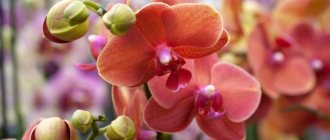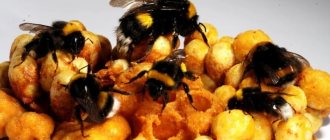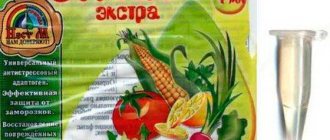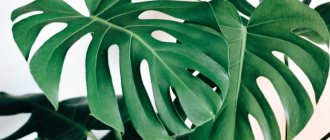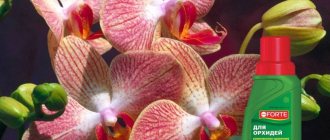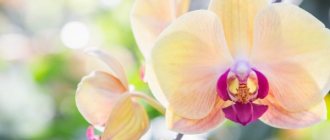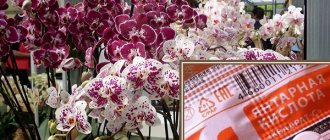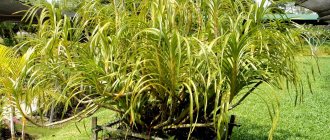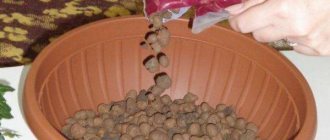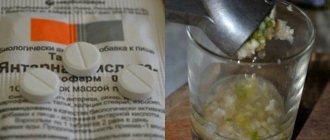Orchids are a beautiful plant. They are quite unpretentious, but sometimes they die for no apparent reason. The main enemy for these flowers is excess water, which causes rotting of the roots and the inept hands of the gardener who decided to replant them immediately after purchase. To reduce all possible risks, it is recommended to use the drug Ribav-extra for orchids.
The product is made from natural ingredients and is non-toxic. This is a concentrate. One 5 ml bottle is designed to process 1 ton of tubers.
Description of the drug
Ribav-Extra is a bioregulatory drug with a universal spectrum of action. Unlike most biostimulating agents, it does not belong to phytohormones.
It has anti-stress properties - it is used to restore weakened and rejuvenate old cultivated plants, and also helps to improve their decorative qualities during the growing season.
It is based on the vital activity of mycorrhiza-forming fungi, which enter into symbiosis with the root system of an indoor flower, as a result of which the latter release biologically active substances, absorbing carbohydrates in return.
With such a mutually beneficial exchange, orchids receive the salts, enzymes and vitamins necessary for growth and intensive root formation.
Thanks to the viability of mycorrhizal fungi, the absorption of nutrition through the roots can increase more than 10 times.
Purpose
The drug is used for:
- root treatments in order to improve rooting, enhanced root formation and survival of flower crops;
- reducing the time of adaptation and survival during transplantation;
- pre-sowing soaking to increase the rate of seed germination and ensure uniformity of seedlings;
- increasing the ability to cope with stressful situations in capricious house flowers, which include orchids;
- accelerating the growth and development of young orchids;
- stimulation of the beginning of the flowering phase in adult plants;
- foliar spraying and watering in order to maintain immunity and resistance to major diseases;
- improving external characteristics and the number of inflorescences and rejuvenating old specimens;
- restoration of green mass after drying out or freezing, or damage to leaves by pests.
Compound
The biostimulant-root-forming agent contains aliphatic amino acids - 2-aminopropane, or alanine, and 2-aminopentanedioic, or glutamic, obtained by biotechnological method from ginseng root. They have a stimulating effect on the viability of plant cells.
Distribution of concentration of active substances:
- 1.52 mg per liter, or 0.0152%) alanine;
- 1.96 mg per liter, or 0.0192% glutamic acid.
The composition contains a solvent - ethyl alcohol (60%).
Has a distinct alcohol smell. Foams when dissolved.
Release forms
Available in the form of ready-to-use solutions.
- Ampoules of 0.5-5 ml and bottles of 5.0-10.0 ml are available for retail sale.
- For industrial use on the agricultural market it is available in 1 liter volumes.
The average price for 1 ml is 30 rubles.
Composition and action
As stated above, Ribav extra is not a phytohormone. Compared to phytohormonal preparations, this growth regulator produces, by analogy with us, not stunted “jocks” who are capable of an instant mighty leap, but rather stunted “jocks” in serious business, but tourists-discharge workers or veteran soldiers. Those who will go everywhere as much as they can, and when they can’t anymore, they will go as long as necessary, or as long as they order.
Area of action of the drug Ribav extra on plants
The effect of Ribav extra on plants affects primarily (see also figure):
- On the acceleration of seed germination, the consistency of seedlings, their rapid growth and development, on the left in the figure;
- Accelerating the rooting of cuttings during vegetative propagation (in the center), as well as increasing the survival rate of seedlings, seedlings and indoor plants during planting, planting and replanting;
- Enhanced root formation and the ability to tolerate stress in orchids and other capricious indoor plants.
Researchers were able to isolate the biologically elementary “building blocks” on which the drug’s action is based. They turned out to be aliphatic amino acids, i.e. having no cyclic bonds in the structural formulas: 2-aminopropane (alanine) and 2-aminopentanedioic (glutamine), see fig. The very mechanism of their action in the required dosages has not yet been solved, but the most important role of amino acids in all living things is undoubted.
Chemical formulas of alanine and glutamic acid
L or R?
In the manufacturer's specification, the components of Ribav extra are listed as L-alanine and L-glutamic acid. In this case, we mean Left spatial isomers, which is determined by the relative position of the amino group and oxygen in the acid residue. In nature, only left-handed isomers are formed and consumed by living organisms; right R (Right) of the same substances are deadly poisons, difficult to synthesize in laboratories. Why, how and why this happened in the process of evolution is a mystery in front of which scientists are only throwing up their hands, relying on quantum physics in the absence of something even more mysterious. As well as solving the main problem of photosynthesis research.
During photosynthesis, a photoreceiver in a plant captures a quantum of light and directs it to a special protein molecule with 100% accuracy. Next, a chain of biosynthesis is launched, which results in a molecule of the universal energy carrier of all living things, adenosine triphosphoric acid. But chemical reactions are fundamentally unable to produce a 100% yield of the final product. And in plants, every suitable quantum of light produces an ATP molecule with 100% probability, and no one can say why this is so yet.
Biologists are also waiting for a complete solution to photosynthesis from quantum physics. Knowledge of its mechanism in all details will make it possible to create artificial photosynthesis. Here prospects open up, about which the wildest imagination can only say – breathtaking. But when and how this will happen – who knows...
Advantages
The drug is suitable for different types
The drug has a number of advantages in comparison with other phytohormonal biostimulants:
- The versatility of the growth regulator allows it to be used for different varieties of orchids.
- If the dosages recommended in the instructions are followed, it has no toxic effect and is safe for plants, humans and animals. Does not have a negative impact on the condition of the soil and the environment.
- The small amount of active substance required to prepare the working solution ensures economical use.
- Compatible with other fertilizers without reducing their effectiveness when used together.
The purpose of using growth stimulants when growing orchids
The issue of using stimulants when growing orchids is a very delicate one. Some experts do not recommend getting carried away with them, considering artificial stimulation harmful to epiphytes:
“Stimulants must be handled carefully. Often gardeners squeeze all the reserves out of a plant, and then are surprised that their orchids quickly age and stop blooming. Epiphytes, in fact, grow and bloom beautifully without any stimulants, if you create the right conditions for them - good light and aeration of the roots, proper watering and moderate mineral supplements.”
A. Davydovskaya, owner of the orchidarium
However, in practice, it is not always possible to create ideal conditions for orchids. Plants stop growing, freeze in the dormant phase, refuse to bloom, and get sick. Therefore, from time to time you have to resort to stimulation.
Rules of application
You can use Ribav-extra for orchids at any stage of the growing season.
However, gardeners consider the initial phase of development to be the best time, which is characterized by a weak proportion of endophytes accumulated in the roots - they are producers of active stimulating substances, and the plant often lacks them at the beginning of intensive growth.
Instructions for use include several steps:
- the initially weakened flower is analyzed for the viability of the root system, removing rotten fragments without affecting the lumps of mycorrhiza;
- the roots are washed from soil residues under running water;
- an aqueous solution with a root former must be diluted in a proportion of 2-3 drops per 1 liter, orchid roots are soaked in it for 12 hours;
- the plant is dried naturally in the open air at a temperature of 22-24 ° C, in a slightly darkened place without direct sunlight and in the absence of drafts;
- if necessary, replace the substrate in the pot with a new one, having previously sterilized it, plant a flower in it;
- after planting, the orchid is watered generously with water at room temperature;
- after 24 hours from the moment of transplantation, watering is carried out with a stimulating solution based on Ribav-extra; according to the instructions, it should be diluted in a lower concentration - in a proportion of up to 2 drops per 1 liter of water;
- in order to further stimulate the revived plant, water it again after 2-3 weeks;
- at the final stage, when the orchid forms the first flower arrow, a third biostimulating watering with the drug is carried out.
You can also use a growth regulator for absolutely healthy specimens. The frequency of treatments to maintain their development and enhance flowering is up to 3 procedures with an interval of 2-3 weeks.
4-24 hours before using Ribav-extra, it is better to water the flower with plain water until the soil is visibly moistened.
The biostimulator is diluted immediately before use. Open ampoules and bottles are not subject to long-term storage, because active substances when in contact with air lose their beneficial properties. Effective shelf life – up to 4 hours.
Analogues of Ribav-Extra
Manufacturers of agricultural chemicals offer a large number of different analogues of Ribav-Extra for orchids. They differ in active ingredients, method of cultivation and processing of plants. Therefore, you should read the instructions before using them.
Drug HB-101
Regulator based on natural extracts.
More details
The drug HB-101 is a natural growth stimulator.
Made from extracts of Japanese cedar, cypress, plantain and pine.
Country of origin: Japan.
The tool will help:
- increase resistance to stress factors;
- will accelerate root regeneration;
- will reduce the recovery time after illness;
- improves leaf and bud shape;
- suppresses pathogenic flora in the soil.
This is a concentrated product.
For treatment, you will need to dilute 1-2 drops of the complex in 1 liter of water.
It is strictly forbidden to use the drug with urea, as well as other oil-based products.
Zircon
Increases disease resistance.
More details
Zircon is a multifunctional complex of non-hormonal origin.
Produced in Russia.
The active ingredient is hydroxycinnamic acids derived from echinacea.
They:
- activate plant growth;
- increase their resistance to environmental factors;
- increase the production of phytohormones.
In addition, the active components of the drug suppress fungal flora.
Zircon is used:
- for soaking seeds during pre-planting preparation;
- spraying plants at different periods of growth.
Available in concentrated form, it is economical.
Necessary Precautions
The biostimulating drug is classified as hazard class 4.
To avoid allergic reactions, all activities are recommended to be carried out using personal protective equipment:
- protect hands with rubber gloves;
- Wear goggles to prevent splashes from spreading into the eyes.
If the substance gets on the mucous membranes and skin, rinse it thoroughly with running water.
You can neutralize the spilled solution using a simple damp or dry napkin (cloth). Cannot be removed from the soil surface, because does not harm the environment.
If amino acids enter the body, they can cause gastrointestinal upset. After seeking medical help, in most cases, treatment is symptomatic.
Store ampoules and vials out of reach of children, in dark places where direct sunlight does not reach.
Classification of stimulants by active ingredients
The active components of growth stimulants may be different. On this basis they are classified as follows:
| Active components of the stimulant | Effect on orchids | Purpose |
| Phytohormones auxins, cytokinins, gibberellins | They activate the elongation and division of stem or root cells, the formation of buds, and accelerate flowering. | Stimulation of growth and flowering of orchids. |
| Phytohormones brassinosteroids | They stimulate the development of seedlings and support immunity in unfavorable conditions. | Relieving stress after exposure to adverse factors, increasing resilience. |
| Vitamins | They enhance the circulation of nutrients in tissues, affect the formation of enzymes, the intensity of photosynthesis, and relieve the consequences of harmful influences. | Stimulates growth and flowering, increases resistance to adverse factors, restores immunity after stress and illness. |
| Amino acids | They increase resistance to osmotic or temperature stress, regulate the functioning of stomata, stimulate the synthesis of their own phytohormones, increase resistance to infections, and activate growth and flowering. | Stimulation of growth and flowering, root formation, increasing resistance to adverse factors, restoration of the lost root system. |
| Organic acids (succinic, citric, malic) | They improve cellular respiration, enhance mitochondrial function and metabolism, accelerate the formation of roots and shoots, increase the length of peduncles, the number and diameter of flowers. | Stimulation of growth and flowering, increasing resistance to adverse factors. |
| Microelements | They influence all biochemical processes, participate in the construction of cells, activate photosynthesis and nutrient transport. | Stimulation of growth and flowering, elimination of mineral starvation, increasing the decorativeness of orchids. |
| Glucose | It is a source of energy for cells, participates in the formation and storage of its own sugars. | Restoration of weakened orchids that have lost leaf turgor, stimulation of their growth, adaptation to lack of irrigation. |
From the table above it is clear that the stimulating effect can be produced in different ways. Some stimulants cause cells to rapidly divide and stretch, others act more gently by increasing the metabolic rate and improving the nutrition of orchids.
Growth stimulants based on phytohormones
This is the most popular, but also the most problematic group of growth stimulants. The peculiarity of phytohormones is that when they are in excess, they can have the exact opposite, inhibitory effect on plants. Orchids are more sensitive to such influences than other plants, so such preparations must be used very carefully when growing them.
Phytohormonal stimulants should be used strictly according to the instructions, avoiding overdose, and only when absolutely necessary. To reduce the likelihood of negative consequences, you simultaneously need to feed orchids and adjust lighting, air temperature and irrigation frequency
The most famous and effective phytohormonal stimulants are the following:
- Heteroauxin. Often used to stimulate the growth of the root system during the resuscitation of orchids. Available in powder or tablet form. The average cost of a package is 30 rubles.
- "Bud". The drug is based on the phytohormone gibberellin. It is used to stimulate the flowering of orchids and increase the number of flowers on the peduncle. Available in water-soluble form. The average price of a package is 40 rubles.
- Cytokinin paste. Used to activate the formation of peduncles or children, to stimulate the opening of the lateral buds of the orchid. Produced by many manufacturers at prices ranging from 80 to 150 rubles.
- "Epin-Extra". The safest of the hormonal stimulants, based on epibrassinolide, is a phytohormone from the group of brassinosteroids. It is used to increase the immunity of orchids, improve their adaptation and growth rate. Available in the form of a solution at a price of 15-20 rubles per ampoule.
Slightly less often, orchid lovers use such drugs from this group as “Ovary”, “Kornevin”, “Gibbersib”.
